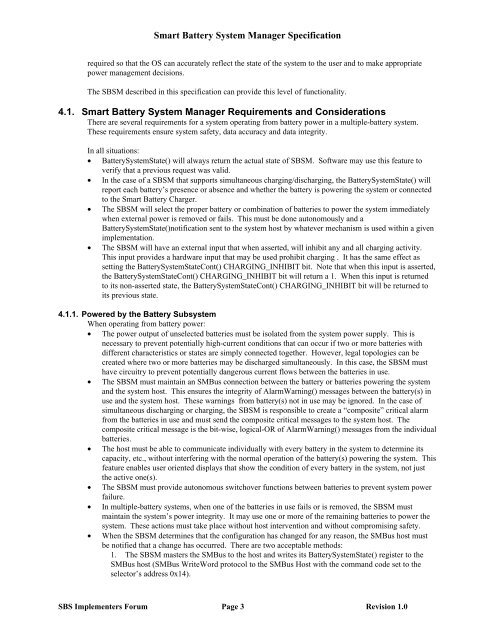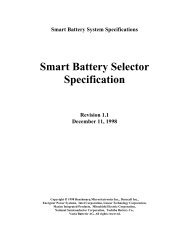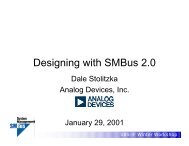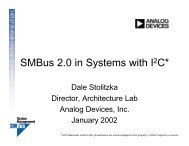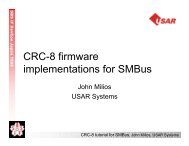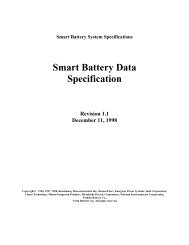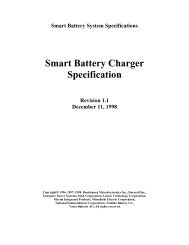Smart Battery System Manager Specification, version 1.0
Smart Battery System Manager Specification, version 1.0
Smart Battery System Manager Specification, version 1.0
You also want an ePaper? Increase the reach of your titles
YUMPU automatically turns print PDFs into web optimized ePapers that Google loves.
<strong>Smart</strong> <strong>Battery</strong> <strong>System</strong> <strong>Manager</strong> <strong>Specification</strong>required so that the OS can accurately reflect the state of the system to the user and to make appropriatepower management decisions.The SBSM described in this specification can provide this level of functionality.4.1. <strong>Smart</strong> <strong>Battery</strong> <strong>System</strong> <strong>Manager</strong> Requirements and ConsiderationsThere are several requirements for a system operating from battery power in a multiple-battery system.These requirements ensure system safety, data accuracy and data integrity.In all situations:• <strong>Battery</strong><strong>System</strong>State() will always return the actual state of SBSM. Software may use this feature toverify that a previous request was valid.• In the case of a SBSM that supports simultaneous charging/discharging, the <strong>Battery</strong><strong>System</strong>State() willreport each battery’s presence or absence and whether the battery is powering the system or connectedto the <strong>Smart</strong> <strong>Battery</strong> Charger.• The SBSM will select the proper battery or combination of batteries to power the system immediatelywhen external power is removed or fails. This must be done autonomously and a<strong>Battery</strong><strong>System</strong>State()notification sent to the system host by whatever mechanism is used within a givenimplementation.• The SBSM will have an external input that when asserted, will inhibit any and all charging activity.This input provides a hardware input that may be used prohibit charging . It has the same effect assetting the <strong>Battery</strong><strong>System</strong>StateCont() CHARGING_INHIBIT bit. Note that when this input is asserted,the <strong>Battery</strong><strong>System</strong>StateCont() CHARGING_INHIBIT bit will return a 1. When this input is returnedto its non-asserted state, the <strong>Battery</strong><strong>System</strong>StateCont() CHARGING_INHIBIT bit will be returned toits previous state.4.1.1. Powered by the <strong>Battery</strong> SubsystemWhen operating from battery power:• The power output of unselected batteries must be isolated from the system power supply. This isnecessary to prevent potentially high-current conditions that can occur if two or more batteries withdifferent characteristics or states are simply connected together. However, legal topologies can becreated where two or more batteries may be discharged simultaneously. In this case, the SBSM musthave circuitry to prevent potentially dangerous current flows between the batteries in use.• The SBSM must maintain an SMBus connection between the battery or batteries powering the systemand the system host. This ensures the integrity of AlarmWarning() messages between the battery(s) inuse and the system host. These warnings from battery(s) not in use may be ignored. In the case ofsimultaneous discharging or charging, the SBSM is responsible to create a “composite” critical alarmfrom the batteries in use and must send the composite critical messages to the system host. Thecomposite critical message is the bit-wise, logical-OR of AlarmWarning() messages from the individualbatteries.• The host must be able to communicate individually with every battery in the system to determine itscapacity, etc., without interfering with the normal operation of the battery(s) powering the system. Thisfeature enables user oriented displays that show the condition of every battery in the system, not justthe active one(s).• The SBSM must provide autonomous switchover functions between batteries to prevent system powerfailure.• In multiple-battery systems, when one of the batteries in use fails or is removed, the SBSM mustmaintain the system’s power integrity. It may use one or more of the remaining batteries to power thesystem. These actions must take place without host intervention and without compromising safety.• When the SBSM determines that the configuration has changed for any reason, the SMBus host mustbe notified that a change has occurred. There are two acceptable methods:1. The SBSM masters the SMBus to the host and writes its <strong>Battery</strong><strong>System</strong>State() register to theSMBus host (SMBus WriteWord protocol to the SMBus Host with the command code set to theselector’s address 0x14).SBS Implementers Forum Page 3 Revision <strong>1.0</strong>


